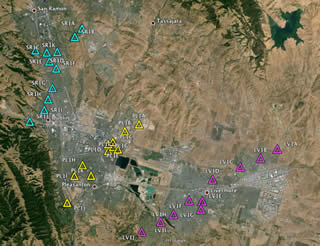San Francisco Bay Area Arrays
Portable Seismograph Deployments to Research the Effects of Basins, Topography, and Fault Zones on Seismic Waves

Pleasanton, and Livermore Valleys.
Seismologists have observed that both topographic highs and basins have complex and varying effects on seismic waves. By deploying arrays of seismic recorders our understanding is improved of what specific features have what specific effects on the seismic waves. These studies use basins, ridges, and fault zones in the San Francisco Bay area as a laboratory to explore in greater detail what is happening as seismic waves propagate through them. The results can be used in similar urban areas throughout the world to estimate the expected shaking from both local and more distant earthquakes.
Seismic waves traveling through basins and topography are affected by:
- The edges of the basin
- The age of the basin, which is related to the density of the material in the basin
- Fault zones in these areas
- The direction of approach of the seismic waves and the shape of the feature
- The distance between the location of the earthquake and the feature
- The frequency content of the seismic waves
The basic approach employed in these studies is to record seismic waves produced from both earthquakes and man-made sources such as explosions, and then to use several different mathematical methods and models to try to explain the observed levels of shaking. The portable seismographs are set up in different arrays in different locations in order to record various effects. Our studies are facilitated by using a combination of different analysis methods to reveal the wave type, direction, and speed of the important components of the ground motion. Both basins and topographic highs can trap seismic waves and cause them to be amplified. An understanding of these amplification effects is important for proper evaluation of seismic hazards in urban areas.
See also:

 Jump to Navigation
Jump to Navigation